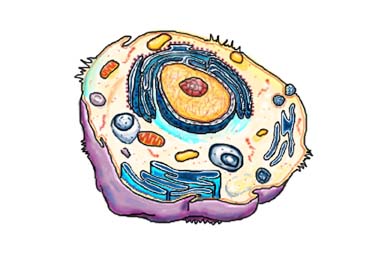Pictures Of Animal Cells Biography
Source:- Google.com.pk
Cell Membrane: Semi-permeable barrier that controls the entry and exit of substances
Cytosol: The fluid portion of the cytoplasm (does not include the organelles or other insoluble materials)
Nucleus: Contains hereditary material (DNA) and thus controls cell activities (via transcription) and mitosis (via DNA replication)
Nucleolus: Site of the production and assembly of ribosome components
Ribosome: Complexes of RNA and protein that are responsible for polypeptide synthesis (eukaryotic ribosomes are larger than prokaryotes - 80S)
Mitochondria: Site of aerobic respiration, which produces large quantities of chemical energy (ATP) from organic compounds
Golgi Apparatus: An assembly of vesicles and folded membranes involved in the sorting, storing and modification of secretory products
Lysosome: Site of hydrolysis / digestion / breakdown of macromolecules
Peroxisome: Catalyses breakdwon of toxic substances like hydrogen peroxide and other metabolites
Centrioles: Microtubule-organising centres involved in cell division (mitosis / meiosis and cytokinesis)
Endoplasmic Reticulum: A system of membranes involved in the transport of materials between organelles
Rough ER: Studded with ribosomes and involved in the synthesis and transport of proteins destined for secretion
Smooth ER: Involved in the synthesis and transport of lipids and steroids, as well as metabolism of carbohydrates
2.3.3 Identify the structures in 2.2.1 in electron micrographs of a liver cell
Electron Micrograph of a Liver Cell
2.3.4 Compare prokaryote and eukaryote cells
Similarities:
Both have a cell membrane
Both contain ribosomes
Both have DNA and cytoplasm
Differences:
2.3.5 State three differences between plant and animal cells
Labelled Diagram of a Generalised Plant Cell
2.3.6 Outline two roles of extracellular components
Plants
The cell wall in plants is made from cellulose secreted from the cell, which serves the following functions:
Provides support and mechanical strength for the cell (maintains cell shape)
Prevents excessive water uptake by maintaining a stable, turgid state
Serves as a barrier against infection by pathogens
Animals
The extracellular matrix (ECM) is made from glycoproteins secreted from the cell, which serve the following functions:
Provides support and anchorage for cells
Segregates tissues from one another
Regulates intercellular communication by sequestering growth factors
Pictures Of Animal Cells Animal Cell Model Diagram Project Parts Structure Labeled Coloring and Plant Cell Organelles Cake


Pictures Of Animal Cells Animal Cell Model Diagram Project Parts Structure Labeled Coloring and Plant Cell Organelles Cake


Pictures Of Animal Cells Animal Cell Model Diagram Project Parts Structure Labeled Coloring and Plant Cell Organelles Cake


Pictures Of Animal Cells Animal Cell Model Diagram Project Parts Structure Labeled Coloring and Plant Cell Organelles Cake


Pictures Of Animal Cells Animal Cell Model Diagram Project Parts Structure Labeled Coloring and Plant Cell Organelles Cake


Pictures Of Animal Cells Animal Cell Model Diagram Project Parts Structure Labeled Coloring and Plant Cell Organelles Cake


Pictures Of Animal Cells Animal Cell Model Diagram Project Parts Structure Labeled Coloring and Plant Cell Organelles Cake


Pictures Of Animal Cells Animal Cell Model Diagram Project Parts Structure Labeled Coloring and Plant Cell Organelles Cake


Pictures Of Animal Cells Animal Cell Model Diagram Project Parts Structure Labeled Coloring and Plant Cell Organelles Cake


Pictures Of Animal Cells Animal Cell Model Diagram Project Parts Structure Labeled Coloring and Plant Cell Organelles Cake


Pictures Of Animal Cells Animal Cell Model Diagram Project Parts Structure Labeled Coloring and Plant Cell Organelles Cake
No comments:
Post a Comment